So... You've got an old car, can't afford a new one, but ya just bought a nitrous 540 - what can ya do???
The internet sites and NSCA pits are full of shiny new entries chocked full of round tubing, exotic interior panels and loads of neat doo-dads that cost a fortune. While these new generation cars do cost quite a bit, the principles applied to them can help your existing car be faster, safer and more consistent.
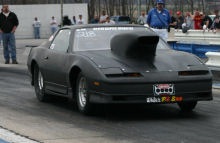 Since dealing with theoretical
stuff can get confusing, let's use a car that passed through the shop here as
an example. Roland Lursky owns an old NHRA Comp Eliminator car- an A Super Mod
something or other that is essentially a stock floor pan Super Stock GT deal.
It's a nice car- the fabrication is top notch, and it performed well for Roland
over the past 3 or 4 seasons with a 500” engine in LS and Super Mod.
Things got interesting when Roland contacted us to do some work for him- and
brought along a very nasty 648” Sonny Leonard engine to shoehorn into it.
Since dealing with theoretical
stuff can get confusing, let's use a car that passed through the shop here as
an example. Roland Lursky owns an old NHRA Comp Eliminator car- an A Super Mod
something or other that is essentially a stock floor pan Super Stock GT deal.
It's a nice car- the fabrication is top notch, and it performed well for Roland
over the past 3 or 4 seasons with a 500” engine in LS and Super Mod.
Things got interesting when Roland contacted us to do some work for him- and
brought along a very nasty 648” Sonny Leonard engine to shoehorn into it.
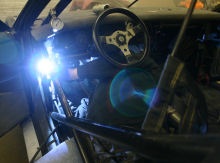 All kidding aside,
the car had previously gone 7.70's with a small nitrous big block (on 10.5's)
and 60 footed fairly well. Initially, we were freaked about whether we could
physically fit the 11.100 Sonny's engine and required big-tube headers into the
car at all- but as it came together, we became more concerned the chassis
wasn't up to the power and tire the car was being outfitted with. Where the
10.5” tire has slipped and spun a bit, we were afraid the big tires would
dead hook, challenging and ultimately bending the outdated chassis. Roland
didn't want to fundamentally alter a good working car without giving it a
chance, so we took a wait and see attitude and headed for Louisiana. While the
wheelies were fun to watch, it became apparent that the point of saturation had
been surpassed. The car was a corkscrewing nightmare that would arbitrarily
wander left or right as the car flexed the long stroke 648 against the 17x33
Mickey's, allowing pre-load to come and go during the run. Since we were
already at the first race, screwing a new car together and staying in the
points chase was out of the question. We needed to get the car back to
Rochester, get working, and do it fast.
All kidding aside,
the car had previously gone 7.70's with a small nitrous big block (on 10.5's)
and 60 footed fairly well. Initially, we were freaked about whether we could
physically fit the 11.100 Sonny's engine and required big-tube headers into the
car at all- but as it came together, we became more concerned the chassis
wasn't up to the power and tire the car was being outfitted with. Where the
10.5” tire has slipped and spun a bit, we were afraid the big tires would
dead hook, challenging and ultimately bending the outdated chassis. Roland
didn't want to fundamentally alter a good working car without giving it a
chance, so we took a wait and see attitude and headed for Louisiana. While the
wheelies were fun to watch, it became apparent that the point of saturation had
been surpassed. The car was a corkscrewing nightmare that would arbitrarily
wander left or right as the car flexed the long stroke 648 against the 17x33
Mickey's, allowing pre-load to come and go during the run. Since we were
already at the first race, screwing a new car together and staying in the
points chase was out of the question. We needed to get the car back to
Rochester, get working, and do it fast.
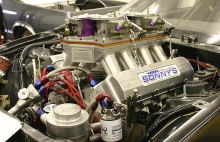 Probably the best thing the
Lursky racing program has going for it is Roland- he's an old school, NHRA, do
what it takes, driven to win kind of guy. He's been running NHRA or IHRA events
since the early eighties- this ain't his first trip to the rodeo and he
understood some surgery was needed to get this car hooked up. The car was
dropped off and we were asked. no, instructed to turn a wheel-standing, wall
hunting over-powered Super Stocker into a low launching Pro Stocker that could
go sub 5.0 in the eighth. When pigs fly, eh?
Probably the best thing the
Lursky racing program has going for it is Roland- he's an old school, NHRA, do
what it takes, driven to win kind of guy. He's been running NHRA or IHRA events
since the early eighties- this ain't his first trip to the rodeo and he
understood some surgery was needed to get this car hooked up. The car was
dropped off and we were asked. no, instructed to turn a wheel-standing, wall
hunting over-powered Super Stocker into a low launching Pro Stocker that could
go sub 5.0 in the eighth. When pigs fly, eh?
Once the car arrived, we got it up on blocks and took a good look at things with the weight of the car on its tires. After familiarizing ourselves with the underside of the car (general IC tune-up, noticed the shocks were in front of the housing, etc.) we plopped it on the scales, looking for imbalanced corner weights. Scales can tip you off to sagging springs or twisted housings, long before you can actually see the car leaning to one side. We checked the suspension for bind, un-screwed the four link bars to inspect the heim rods, and inspected the four link brackets and housing for cracks. Finding nothing that would cause Roland's launching and handling issues, we started breaking down what areas on the car appeared to be up to the task and what didn't.
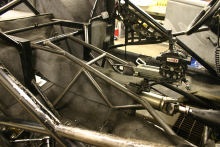 In the back of the car the
frame was constructed out of .125 2X3 box tubing. It was well supported by the
1 5/8 .083 Chromoly back bars and diagonals off the shoulder bar at the shock
crossmember. This was the best the car had to offer, however. The acid dipping
left everything forward of the main hoop in need of some help. Tubing that
relied on the floor or factory rails for support didn't have a stable enough
platform to do its job. The front bulkhead at the rear of the sub frame had
been whittled down for header clearance, and hairline cracks around the
remaining spot welds showed this area was incapable of supporting the loads
placed on it by the 2x2 sub frame connector welded along its rear section.
In the back of the car the
frame was constructed out of .125 2X3 box tubing. It was well supported by the
1 5/8 .083 Chromoly back bars and diagonals off the shoulder bar at the shock
crossmember. This was the best the car had to offer, however. The acid dipping
left everything forward of the main hoop in need of some help. Tubing that
relied on the floor or factory rails for support didn't have a stable enough
platform to do its job. The front bulkhead at the rear of the sub frame had
been whittled down for header clearance, and hairline cracks around the
remaining spot welds showed this area was incapable of supporting the loads
placed on it by the 2x2 sub frame connector welded along its rear section.
A diagonal was run from between the 2" x 3" rear framerails forward onto the 2x2 just behind the bulkhead under Roland's feet, and another diagonal went from the dash/a-pillar bar to the area behind the pedals- where the factory front subframe was still strongest. The subframe itself was plated under the floor so it could accept the added loads being placed upon it. Small diameter verticals triangulated the assembly to the rib area under the stock floor on plates. Behind Roland, we needed to give the single X that was supporting the main hoop a little help, and placed simple, conventional downbars to the back and triangulated things so the car had a better chance of staying square on launch.
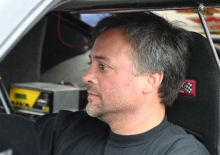 The final addition was the
fabrication and installation of an anti-roll bar. Lots of theories abound about
the diameter, material and placement of the device, but in a case like
Roland's, the obstacles presented by the stock floor dictated its location. It
ended up directly behind the housing aiming forward. We used a fairly light
material for the torsion bar when compared to some, believing that even with
our upgrades, we were sill dealing with a relatively flexible car when
contrasted to the newest double rail cars, and that these cars must be equipped
as a package, not arbitrarily jammed together. Time will tell if the bar twists
and loses square- Roland's on top of his stuff and he'll know if something's
up. So far, so good.
The final addition was the
fabrication and installation of an anti-roll bar. Lots of theories abound about
the diameter, material and placement of the device, but in a case like
Roland's, the obstacles presented by the stock floor dictated its location. It
ended up directly behind the housing aiming forward. We used a fairly light
material for the torsion bar when compared to some, believing that even with
our upgrades, we were sill dealing with a relatively flexible car when
contrasted to the newest double rail cars, and that these cars must be equipped
as a package, not arbitrarily jammed together. Time will tell if the bar twists
and loses square- Roland's on top of his stuff and he'll know if something's
up. So far, so good.
What was the result of all these shenanigans? After one test session, the car picked up .06 to the sixty foot and an additional .02 between the 60 and the 330 foot clocks. Total improvement to the eighth was .08, with no gain or loss in mph. That's significant... it's proof the car was wasting less energy. The wheel stands are gone, the car takes off with the front tires an inch or two off the ground and heads straight down the groove, efficiency replacing flex with forward propulsion. His best 60' times to date in the car are 1.11 on 17x33's at 3000 lbs. with a 500" nitrous motor, 1.12 on the big tires with the big inch N/A motor and a stout 1.13 on 10.5's with the same N/A piece, old school 2x2 and stock floor still in place.
Did we do anything difficult? I don't think so. Perhaps every home hobbyist can't get the same results we did but I will promise you this: there are changes you can make to your own car that will upgrade its performance and consistency. Any effort you make to strengthen the car down it's middle section to the mid plate area will pay big dividends if executed properly.
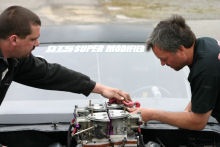 As the
new 25-4 and 25-5 specs come down the pike, take a long look at your ride,
especially if you will be updating it as opposed to cutting it apart and
re-doing it. Are the four link brackets properly positioned in the car? Is the
engine as low as it could be in the chassis? Is the driveline's relationship to
the pinion correct? Many of the bars required for you to pass this spec can pay
a performance benefit if you consider their placement carefully, and
considerable gains can be made if additional gussets and diagonals are
installed during the update. Many ignorantly claim that 25.1 ruined the street
legal movement. In reality, a car carrying a 25.1 tag only means it passed a
safety test, it has no inherent performance edge. The performance edge that
accompanies that tag generally comes from the greater thought that was put into
building the car. Properly located 4-link brackets are not exclusive to round
tube cars, but many 2x3 cars were built on garage floors with little
understanding of suspension geometry. (It's easy to cut brackets off a 2x3 car-
ask some questions and make sure yours are in correctly if it's update time.)
Round tube cars are typically built on jigs, making the proper and often lower
placement of the driveline easier to execute, while 2x3 backhalf cars are often
constructed using the factory mounts as guidelines.
As the
new 25-4 and 25-5 specs come down the pike, take a long look at your ride,
especially if you will be updating it as opposed to cutting it apart and
re-doing it. Are the four link brackets properly positioned in the car? Is the
engine as low as it could be in the chassis? Is the driveline's relationship to
the pinion correct? Many of the bars required for you to pass this spec can pay
a performance benefit if you consider their placement carefully, and
considerable gains can be made if additional gussets and diagonals are
installed during the update. Many ignorantly claim that 25.1 ruined the street
legal movement. In reality, a car carrying a 25.1 tag only means it passed a
safety test, it has no inherent performance edge. The performance edge that
accompanies that tag generally comes from the greater thought that was put into
building the car. Properly located 4-link brackets are not exclusive to round
tube cars, but many 2x3 cars were built on garage floors with little
understanding of suspension geometry. (It's easy to cut brackets off a 2x3 car-
ask some questions and make sure yours are in correctly if it's update time.)
Round tube cars are typically built on jigs, making the proper and often lower
placement of the driveline easier to execute, while 2x3 backhalf cars are often
constructed using the factory mounts as guidelines.
Roland's car was like many existing cars out there that owners cannot afford to replace, yet fail to meet customer's needs. They can be improved, if time and thought are given to the repair. Square tube, round tube, whatever - The car only knows if it's strong and able to respond to tuning input, critical to safely campaigning a car. Take a look at what works, fire up the fire ax and have at it- just make sure you read and adhere to the provided instructions relative to bracket height/shock centers, etc. (if you buy a kit, there are many out there) and have a clear and concise plan of attack.
